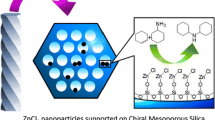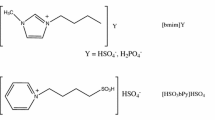Abstract
The involvement of alkanes in selective transformations is one of the fundamental problems of organic chemistry. On the one hand, alkanes and cycloalkanes, which are the main components of oil and natural gas, still remain the most promising starting compounds for organic synthesis. On the other hand, present industrial processing of hydrocarbon raw materials requires the development of new technologies based on application of more selective catalysts.
Access this chapter
Tax calculation will be finalised at checkout
Purchases are for personal use only
Preview
Unable to display preview. Download preview PDF.
Similar content being viewed by others
References
Olah, GA, Prakash, G.K.S., and Sommer, J. (1985) Superacids, Wiley-Interscience, New-York; (b) Olah, G.A., and Prakash G.K.S. (1992) The chemistry of alkanes and cycloalkanes, in: S. Patai and Z. Rappoport (eds.), Wiley & Sons, Chichester, Chap. 13.
Hill, C.L. (Ed.) (1992), Activation and functionaUzation of alkanes, Wiley & Sons, New-York; (b) Crabtree, R.H. (1992) Organometallic chemistry of alkane activation, in: S.Patai and Z.Rappoport (eds.), Wiley & Sons, Chichester, Ch. 14; (c) Arndtsen, B.A., Bergman, R.G., Mobley, T.A., and Peterson, T.H. (1995) Selective intermolecular carbon-hydrogen bond activation by synthetic metal complexes in homogeneous solution, Acc. Chem. Res. 28(3), 154-162; (d) Shilov, A.E. and Shul’pin, G.B. (1997) Activation of C-H bonds by metal complexes, Chem.Rev. 97(8), 2879-2932.
Somorjai, G.A. (1978) Surface science: an old field rejuvenated demands attention and people, Science, 201, 489; (b) Somorjai, G.A. (1992) Correlations and difference between homogeneous and heterogeneous catalysis — as surface science view in perspectives in catalysis, IUPAC Series: Chemistry for the 21 stCentury, J. Thomas and K. Zamaraev (eds.), Blackwell Science Publ., London, pp. 147-167.
Hill, C.L. (1995) Introduction of functionality into unactivated carbon-hydrogen bonds. Catalytic generation and nonconventional utilization of organic radicals, Acc. Chem. Res. 28, 127–132; (b) Ilhyong, and R., Sonoda, N. (1996) Free-radical carbonylations: then and now, Angew. Chem. Int. Ed. Engl 35, 1050-1066.
Akhrem, I.S., Orlinkov, A.V., Mysov, E.I., and Vol’pin, M.E. (1981) Transformations of cycloalkanes under the action of acylhalides in the presence of AlBr3, Tetrahedron Lett. 22, 3891–3894: (b) Vol’pin, M., Akhrem, I., and Orlinkov A. (1989) Aprotic organic superacids — efficient reagents and catalysts for transformations of alkanes and cycloalkanes under mild conditions, New J. Chem. 13, 771-790.
Akhrem, I.S., Orlinkov, A.V., and Vol’pin, M.E. (1996) Low-temperature functionaUzation of alkanes and cycloalkanes by “classical” and “nonclassical” (superacidic) Friedel-Crafts complexes, Russ. Chem. Rev. 65 (10), 849-863 (Uspekhi Khimii, 65(10), 920–935).
Akhrem, I.S., Orlinkov, A.V., Bachmutov, V.I., Afanas’eva, L.V., and Vol’pin, M.E. (1990) Nature of the species responsible for the high activity of RCOX-2A1X3 complexes in reactions with alkanes and cycloalkanes, Russ. Chem. Bull. 39, 2252–2257 (Izv. Akad. Nauk SSSR, Ser. Khim. 39, 2490-2496).
Akhrem, I.S., Orlinkov, and Vol’pin, M.E. (1993) A novel family of aprotic organic superacids for low-temperature alkane and cycloalkane transformations, J. Chem. Soc., Chem. Commun, 671-672; (b) Akhrem, I.S., Afanas’eva, L.V., Orlinkov, A.V., and Vol’pin, M.E. (1994) Halogens (Cl2, Br2, I2) promoted by aluminium halides as effective initiators for alkane cracking, Mendeleev Commun., 131-133: (c) Akhrem, I., Gudima, S., and Vol’pin, M. (1996) Novel sulfur-containing inorganic aprotic superacids as effective initiators of low-temperature cracking and isomerization of alkanes, Chem. Eur. J. 2, 812-814.
Akhrem, I.S., and Orlinkov, A.V. (1998) Novel superelectrophilic complexes for low-temperature alkane and cycloalkane transformations, Russ. Chem. Bull. 47(5), 740–764 (Izv. Akad. Nauk, Ser. Khim. 47(5), 771-795).
Akhrem, I.S., Orlinkov, A.V., Afanas’eva, L.V., and Vol’pin, M.E. (1998) Cracking n-alkanes under the action of aprotic superacids at room temperature, Dokl. Akad. Nauk SSSR, 298, 107–112.
Orlinkov, A.V., Akhrem, I.S., Afanas’eva, L.V., and Vol’pin, ME. (1986) Isomerization of butane catalyzed by CH3COX-2AtX3, Bull. Acad. Sci. USSR, Div. Chem. Sci., 35, 1286–1289 (Izv. Akad, Nauk SSSR, Ser. Khim., 35, 1416-1419); (b) Orlinkov, A.V., Akhrem, I.S., Afanas’eva, L.V., and Vol’pin, M.E. (1984) Synthesis of isobutane, USSR Author Certificate 1224552.
Orlinkov, A.V., Akhrem, I.S., Afanas’eva, L.V., and Vol’pin, M.E. (1984) USSR Author Certificate 1197370.
Orlinkov, A.V., Akhrem, I.S., Afanas’eva, L.V., Zaharkin, L.I., Ovseenko, S.T., and Vol’pin, M.E. (1990) Isomerization of C12H20 tricyclanes into dimethyl-and ethyladamantanes by the action of acylbromide with aluminium bromide, Russ. Chem. Bull., 39, 290–292 (Izv. Akad, Nauk SSSR, Ser. Khim. 39, 349-352).
Akhrem, I.S., Orlinkov, A.V., Vitt, S.V., and Vol’pin M.E. (1986) Alkylation of adamantane with n-alkanes under mild conditions, Dokl. Akad. Sci. USSR 288(1), 130–134.
Schwarte, D. (1960) Isomerization of straight-chain hydrocarbons to isoparaffins, US Patent 2, 956,095 [Chem. Abstracts (1961) 55, 5931h].
Mahan, J., and Morell, J. (1974) Isomerisation with arsenic pentafluoride and/or antimony pentafluoride and with trifluoromethanesulfonic acid or hydrogen fluoride and high hydrogen partial pressure, US Patent 3, 839,489 [Chem. Abstracts (1975) 82, 88376d].
Norell, J.R. (1973) Normal paraffin isomerization with liquid-phase arsenic pentafluoride-hydrogen fluoride catalyst, US Patent 3,755,493 [Chem. Abstracts 79, 125794z].
Montgomery, C.W., McAteer, J.H., and Franke N.W. (1937) Catalytic isomerization of n-butane and isobutane, J. Amer. Chem. Soc. 59, 1768–1769.
Adrianus, J., van Peski, A.J., and Gerardur, H.V. (1940) Isobutane, US Patent 2,249,366 [Chem. Abstracts (1941) 35, 6601g].
Olah, G.A., Laali, K., and Farooq, O. (1984) Chemistry in superacids. 6. Perfluoroalkane sulfonic acid-boron sulfonates: new superacid systems for generation of carbocations and catalysts for electrophilic transformations of hydrocarbons, J. Org. Chem. 49, 4591–4594.
Brouwer, D.M. and Kiffen, A.A. (1973) Hydride transfer reactions. II. Hydride transfer from alkanes to methyloxocarbonium ion, Rec. Trav. Chim., Pays-Bas 92, 689–697.
Fort, R.C. (1976) Adamantane, the chemistry of diamond molecules, Dekker, New York; (b) Bagrii, E.I. (1989) Adamantanes: production, properties, application, Nauka, Moscow (and references cited therein).
Akhrem, I.S., Orlinkov, A.V., Afanas’eva, L.V., Mysov, E.I., and Vol’pin, M.E. (1995) Ionic bromination of ethane and other alkanes (cycloalkanes) with bromine catalyzed by polyhalomethane-2AlBr3 aprotic organic superacids under mild conditions, Tetrahedron Lett. 36, 9365–9368; (b) Akhrem, I.S., Orlinkov, A.V., Afanas’eva, L.V., and Vol’pin, M.E. (1996) Functionalization of saturated hydrocarbons by aprotic superacids. 4. Ionic bromination of ethane and other alkanes and cycloalkanes with molecular bromine in the presence of systems based on polyhalomethanes-AlBr3 under mild conditions, Russ.Chem. Bull. 45, 1148-1153 (Izv. Akad, Nauk SSSR, Ser. Khim., 45, 1208-1213).
Akhrem, I.S., Bernadyuk, S.Z., and Vol’pin, M.E. (1993) Carbonylation of cyclopentane in the presence of aprotic organic superacids, Mendeleev Commun., 188-189.
Orlinkov, A., Akhrem, I., and Vitt S. (1999) The first efficient carbonylation of ethane with CO, Mendeleev Commun. 198–199.
Amiantov, I.Yu., Khotsyanova, T.L., Akhrem, I.S., Orlinkov, A.V., and Vol’pin, M.E. (1984) Study of the structures of the complexes of acylbromide with AlBr3 by 8lBr NQR at — 77K, Zh. Struct. Khim. 25(5), 46–50.
Akhrem, I.S., Orlinkov, A.V., Bakhmutov, V.I., Petrovskii, P.V., Pekkh, P.I., Lipmaa, E.I., and Vol’pin, M.E. (1985) Study of the nature of the complexes acyl bromide-2(aluminum bromide), acyl chloride-2(aluminum chloride) and acetyl chloride-2(antimony (V) fluoride) using proton, carbon 13, aluminum 27, fluorine 19 and oxygen 17 NMR, Dokl. Akad. Nauk SSSR 284, 627–631.
Stankevich, I.V., Chistyakov, A.L., Akhrem, I.S., Orlinkov, A.V., and Vol’pin, M.E. (1993) Electronic population structure and stability of organic cations, dications and donor-acceptor complexes. The MNDO calculations of possible intermediates in MeCOCl-nAlCl3 systems, Russ. Chem. Bull. 42, 802–809 (Izv. Akad. Nauk, Ser. Khim., 42, 854-858).
Bertram, J., Coleman, J.P., Fleishmann, M., and Pletcher, D. (1973) The electrochemical behaviour of alkanes in fluorosulfonic acid, J. Chem. Soc., Perkin II, 374–381.
Olah, G.A., Germain, A., Lin, H.C., Forsyth, D.A. (1975) Electrophilic reactions of single bonds. XVIII. Indication of protosolvated de facto substituting agents in the reactions of alkanes with acetyluim and nitronium ions in superacidic media, J. Amer. Chem. Soc. 97, 2928–2929.
Koch, W., Frenking, G., Schwarz, H., Maquin, F., and Stahl, D. (1985) Theoretical and experimental studies on the ground state potential energy surface of C2H4O dications, Int. J Mass. Spectrom. Ion Processes 63, 59–82.
Olah, G. A., Burrichter, A., Rasul, G., Prakash, G.K.S., Hachoumy M., and Sommer, J. (1996) Protioacyl dications: hydrogen/deuterium exchange, rearrangements and theoretical studies, J. Amer. Chem. Soc. 118, 10423–10428.
Olah, G.A. (1993) Superelectophiles, Angew. Chem. Int. Ed. Engl. 32, 767–788.
Olah, G.A., (1995) My search for carbocations and their role in chemistry (Nobel lecture), Angew. Chem. Int. Ed. Engl. 34, 1393–1405.
(a) Ohwada, T., Yamagata, N., and Shudo, K.(1991) Friedel-Crafts-type reactions involving di-and tri-cationic species. Onium-allyl dications and O, O-diprotonated aci-nitro species bearing a protonated carbonyl group, J. Amer. Chem.Soc. 113, 1364–1377.; (b) Sato, Y., Yato, M., Ohwada, T., Saito, S., and Shudo K. (1995) Involvement of dicationic species as the reactive intermediates Gattermann, Houben-Hoesch and Friedel-Crafts reactions of nonactivated benzenes, J. Amer. Chem. Soc. 117, 3037-3043.
Chistyakov, A.L., Stankevich, I.V., Akhrem, I.S., Gambaryan, N.P., and Vol’pin, M.E. (1996) Electronic structure, geometry and stability of organic cations, dications and donor-acceptor complexes. 2. Polyhalomethane complexes with aluminium halides, Russ. Chem. Bull. 45, 514–520 (Izv. Akad. Nauk, Ser. Khim. 45, 554-560).
(a) Olah, G.A., Rasul, G., Heiliger, L., and Prakash, G.K.S. (1996) Preparation, and NMR spectroscopic and ab initio/DFT, GIAO-MP2 studies of halomethyl cations, J. Amer. Chem. Soc. 118, 3580–3583; (b) Franking, G., Fau, S., Marchand, C.M., and Grutzmacher, H.(1997) The π-donor ability of the halogens in cations and neutral molecules. A theoretical study of AX3′, AH2X′, YX3 and YH2X (A = C, Si, Ge, Sn, Pd; Y = B, Al, Ga, In, Tl; X = F, Cl, Br, I), J. Amer. Chem. Soc. 119, 6648-6655.
Olah, G.A., Rasul, G., Yudin, A., Burrichter A., Prakash, G.K.S., Chistyakov, A.L., Stankevich, I.V., Akhrem, I.S., Gambaryan, N.P., and Vol’pin, M.E. (1996) Trihalomethyl cations and their superelectrophilic activation, J. Amer. Chem. Soc. 118, 1446–1451.
Akhrem, I.S., Chistyakov, A.L., Gambaryan, N.P., Stankevich, I.V., and Vol’pin, M.E. (1997) Polyhalomethanes combined with aluminum halides as generators of superelectrophiles of a novel type, J. Organomet. Chem. 536, 489–495.
Author information
Authors and Affiliations
Editor information
Editors and Affiliations
Rights and permissions
Copyright information
© 2003 Springer Science+Business Media Dordrecht
About this chapter
Cite this chapter
Akhrem, I.S., Orlinkov, A.V., Vol’Pin, M.E. (2003). Alkane and Cycloalkane Transformations in Superelectrophilic Liquids. In: Rogers, R.D., Seddon, K.R., Volkov, S. (eds) Green Industrial Applications of Ionic Liquids. NATO Science Series, vol 92. Springer, Dordrecht. https://doi.org/10.1007/978-94-010-0127-4_28
Download citation
DOI: https://doi.org/10.1007/978-94-010-0127-4_28
Publisher Name: Springer, Dordrecht
Print ISBN: 978-1-4020-1137-5
Online ISBN: 978-94-010-0127-4
eBook Packages: Springer Book Archive




